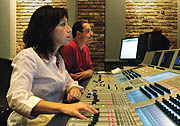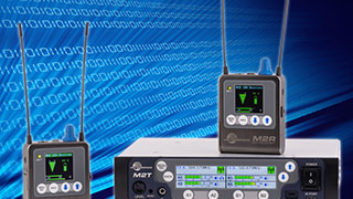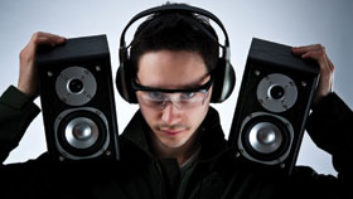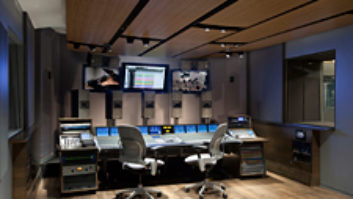
Advantage Audio’s Melissa Ellis and Fil Brown at the Studer Vista 7, which is linked to Pro Tools and RADAR 24
As we move precipitously closer to the FCC’s mandate for broadcasters to complete the transition from analog to digital TV — currently set for late 2006 — there is no denying that SD and HD are taking on an increasing importance in the minds of consumers and professionals alike. Sales of high-definition, digital-ready TV receivers and monitors continue to climb (according to The New York Times, more than a million DTV sets were sold in October 2004), while mixing for a 5.1-channel broadcast is assuming a more routine definition.
While hi-def programming was kick-started primarily with sports and entertainment programming, in the past year, prime-time offerings — from cable and all major networks — have been flooding the airwaves, complete with discrete 5.1-channel Dolby Digital soundtracks, including those for Alias, Desperate Housewives, George Lopez, CSI (all iterations), ER, Joey, Law and Order (all iterations), Medium, 24, American Idol, Arrested Development and NASCAR — and this is just a small sampling. NBC’s The Tonight Show With Jay Leno has been in HDTV for a while, and HBO now releases most of its series specials in 5.1. The extra $10 on the cable bill is beginning to seem almost worth it.
At Technicolor Hollywood, senior film/TV mixing engineer Andre Perreault handles 5.1 sound for a number of TV shows including Judging Amy, Summerland and Father of the Pride, as well as movies of the week. “The key to a good HDTV mix,” Perreault says, “is to use film-style techniques with no compromise. At the same time as I’m developing the 5.1-channel surround mix, I’m also preparing a [matrix-encoded Lt/Rt] Dolby Surround for conventional 2-channel broadcast.”
Perreault’s Stage 2 features an SSL Avant Plus digital assignable console linked to Digidesign Pro Tools for playback and Fairlight MFX-3s for 24-bit recording of stems and finals. (Stages 1 and 3 at Technicolor Hollywood are similarly equipped.) “I always mix on the large monitors in surround,” the engineer continues, “and then use a normal TV with built-in [2-channel] speakers for playback with the producer. If there are changes, I can modify both mixes at the same time on the Avant. Everything must sound good on the 2-track, but the 5.1-channel mix is also important for not only the HD broadcast, but also future DVD releases.”
One of the biggest hurdles to overcome, Perreault considers, is production dialog. “Because of tight schedules, the hard-working production mixers often cannot secure the best dialog tracks. The good crews are the ones that can do their best [under the circumstances] and get the best results.” Perreault uses a number of tools, including Dolby CAT cards and CEDAR units, but prefers well-recorded tracks. “Also, with all-digital systems, you have to watch out for sync problems. We prelay everything here in the room and monitor constantly for ticks and pops.”
Perreault generally mixes hourlong shows such as Judging Amy in two days, including prelay. “Day one, we load everything into Pro Tools from the server. Ken Burton, my effects mixer, has a 96-track Pro Tools while I use a 32-track system for dialog. After lunch we add the music, which arrives in a separate Pro Tools drive, and then build the mixes using 6-channel stems. Dialog is in the center, with group walla in the surrounds and left and right, plus music spread across the soundfield and into the surrounds; effects are a full 5.1 mix. Within the Avant, I have built a submix for the 2-channel balance that follows gain changes made to the 5.1 mix.

Sitcom mixer Charlie McDaniel (Warner Bros.) developed templates on the AMS Neve DFC console to prep for George Lopez’s incoming Spanish-language dialog tracks.
“Day two, we go through final changes with the producers, and by lunchtime we have a final playback. Then in the afternoon, we complete the layback of DME stems and the final 5.1-channel print mastering to the MFX-3 recorder. Having digital picture speeds up the process dramatically, and since we automate everything, the final mixes can be played back from RAM.”
THE ANIMATION ADVANTAGE
Advantage Audio (Burbank, Calif.) handles a wide cross-section of multichannel programming and has recently completed work on a number of animated series including Kim Possible for Walt Disney Television Animation. The facility’s pair of identical stages house Studer Vista 7 digital consoles linked to Pro Tools playback and iZ Technologies RADAR 24 systems for stem recording. “Stage A is where Melissa Ellis and Fil Brown handle mixing multiple versions of the [Kim Possible] project,” points out Advantage Audio co-owner Bill Koepnick. In addition to discrete 5.1-channel and Lt/Rt Dolby surround mixes for The Disney Channel and other outlets, Advantage needed to prepare home-video DVD releases of three episodes edited into a single 70-minute offering, plus a Dolby Surround mix for international release and use on ABC-Television, Disney’s Family Channel and others.
“More and more shows are being mixed in 5.1,” Koepnick offers, “even if they are not yet being broadcast in that format. If you plan for it and have the elements, 5.1 doesn’t take much more time to mix than stereo — the differences are mainly in print mastering. You need more time to generate the necessary elements and prepare stems, and final print mastering has more steps and takes far longer. We need to be more efficient and have sharper tools!
“The effects tracks [for Kim Possible] took around two weeks to build,” recalls Koepnick, “including 4-channel backgrounds with diffuse ambiences for the surrounds. The DVD project took six days for the mix and a day for print mastering.”
“Our room’s quartet of Pro Tools systems,” adds mixer Ellis, “played back 24 tracks of effects, as many as 24 tracks of music [prepared off-site by composer Adam Berry], up to 16 tracks of dialog and up to 16 tracks of Foley. Once we have the dialog elements balanced, I begin to work on the effects tracks while Fil [Brown] handles Foley and music.” Effects are also prepared in Propellerhead Software’s Reason and replayed from various samples. “It’s an easy-to-use application,” Koepnick considers, “and we can use ReWire to re-record the elements into Pro Tools.”
A virtual mix is built in the Vista 7’s console automation, with stems being recorded to the RADAR 24 along with a composite master. “We do an effects/Foley stem in 5.1, dialog in 5.0, music in 5.1 — although there is not much in the LFE — and the complete mix to 5.1,” continues Koepnick. “Having completed the 5.1 and Lt/Rt print mastering, we also lay off an M&E mix.”

Larry Benjamin of Technicolor Burbank at the Digidesign ICON
Regarding the facility’s console choice, Koepnick says, “Of all the consoles out there, [the Vista 7] has the most efficient user interface. Our mixers like the knobs-on-glass, icon-based controls that let them see very quickly what a control is assigned to and what setting is being displayed. Speed is very important in today’s high-pressure sessions: You cannot look for a control — it must be there and ready to go.”
MULTILINGUAL WARNER
One of the busiest mixers in TV post — in the hectic world of sitcoms, at least — is Charlie McDaniel, who helms an AMS Neve DFC digital console in Warner Bros.’ Stage 8 on the Burbank, Calif., lot. Current shows include Complete Savages, Less Than Perfect, That ’70s Show, Yes, Dear, King of Queens, George Lopez, Half and Half, Center of the Universe, Joey and Wife and Kids. In terms of complexity, McDaniel says that the WB’s George Lopez presents some major audio challenges. “We mix a Spanish-language SAP channel for the show in addition to a full 5.1-channel mix,” he explains, adding that it is mixed with backgrounds and Foley like a regular mix. “We need to reduce the dynamics for the 2-channel SAP mix and brighten the track to overcome the reduced bandwidth, which is handled using print mastering.”
To streamline the SAP mixing process, the show’s production company, SPG Studios, delivers Spanish-language dialog tracks via ISDN from a voice-over studio in Mexico. “Using a series of templates that I developed for the DFC console,” McDaniel continues, “I can prepare stereo and Dolby Surround balances from the 5.1-channel stems.” Edited sound effects, ADR, Foley and backgrounds arrive on Fairlight MFX-3 drives, with everything else on Pro Tools. Stems are recorded to a 20-track format, with final delivery of the 5.1 channel and stereo via Dolby E-encoded tracks on the video master.
“I use the surrounds sparingly,” the engineer concedes. “I might place some music back there with backgrounds and some panned effects; I prefer to keep the audience primarily in the front. And for sitcoms, we use the boom [LFE] channel for music and not much else. One problem is that the audience mics [during the live videotaping] can pick up rumble from the soundstage and I need to make sure that the dialog can be held above any low-frequency material.
“We mix the show in a day,” McDaniel adds. “Assembling the elements onto our Pro Tools systems [assisted by his A2, Robert Bradford III] and getting a trial balance takes around four hours, depending on how complex the show is, and we spend an hour on the SAP mix. Then we printmaster the stereo and 5.1-channel mixes…and we’re done!” The mixer says that the 40-channel/four-layer DFC Gemini saves a great deal of time, “because I can store EQ settings, for example, for different shows; each soundstage has its own ‘quirks,’ and so I developed curves that I can recall at the press of a button. Coming from an analog background, the learning curve [on the digital assignable console] was much less than I thought it would be.”

Hank Neuberger, left, and Terry Fryer at Third Wave Productions, Chicago
CONTROL MEANS SPEED
With digital audio workstations offering mind-numbing processing power, a number of manufacturers have developed control surfaces for DAWs that enable all editing, processing and mixing functions to be handled within a fully integrated environment. Technicolor Burbank recently installed a dual-operator Digidesign ICON in Victory Stage A, where Larry Benjamin and Ross Davis mix JAG and NCIS in 5.1. “We have been using the ICON since July [2004],” Benjamin says, “and it is a great time-saver for us. We mix JAG in three days: half a day to assemble the elements and lay out the mix; one to two days to mix and handle fixes for the producers; and then the remainder of the third day to make final fixes and printmaster.” Currently, the show is broadcast in Dolby Surround, but CBS Television plans to offer it in 5.1 next year. Discrete multichannel mixes are prepared for possible DVD release and for forward compatibility.
“We access Pro Tools files directly within the machine room,” Benjamin explains, “or via our FTP-based server; ADR arrives on CD-ROMs. We end up with eight tracks of dialog, eight of ADR, eight of Foley, eight of group, 16 of background effects and between 24 and 40 tracks of hard effects. Music is supplied as a 3-track/LCR orchestral score, plus individual sources for JAG and multiple tracks for NCIS.
“Mixing in the box [using ICON] means that all reverb, EQ and dynamics settings are stored with the project,” he continues. “The only outboard I use is a Cedar DNS 1000 for cleaning up air conditioning and broadband noise. The ICON’s [D-Control] surface acts like a regular console, and the combination of mixing and sound editorial is totally seamless. We use the [Pro Tools] editing functions all the time to move elements or to clear up dialog bumps, et cetera. If necessary, Ross [Davis] can also replace things like gun shots quickly using our effects libraries.
“[Such a system] changes your view on mixing,” Benjamin concludes. “Full automation of everything is outstanding. We can accommodate picture changes [from AVID editors] using automated conform, which is very fast. We also use QuickTime Picture, which speeds up moving around a project. We can also run both console sections independently, which means that I can be making dialog EQ changes, for example, while [Ross] handles something else. It can be disturbing for the producers because it sometimes makes it hard to follow what we are doing. But we provide a play-by-play so they know [what we are doing at the console]. This approach of working offline was quickly embraced by the producers who immediately understood the benefits.”
QUE UP QUALITY CONTROL
While post stages are capable of producing stunning multichannel mixes for a number of broadcast outlets, it is all too easy for these materials to be compromised before they reach their intended audience. In addition to post-producing 10 half-hour episodes of the hi-def Fields of Glory college football series for the new InHD Network with a full 5.1-channel soundtrack, Chicago’s Third Wave Productions has also developed a very useful quality-control process. According to co-founders Terry Fryer and Hank Neuberger, it is all too easy to overlook format compatibility.
“For Fields of Glory, we need to provide a conventional stereo mix, a [matrix-encoded] Dolby Surround Lt/Rt mix and discrete 5.1-channel mix,” Fryer explains. “To create a convincing surround environment, spaced mics are not very convincing. We use a 6-channel Holophone microphone to capture ambiences, locker room and crowd sounds. In addition to creating the sense of ‘you are there’ in our mixes, the Holophone is far more mono/stereo/surround-compatible than other transducers.”
“But we also realized,” Neuberger adds, “that we cannot mix and monitor in 5.1 channel and assume that the Dolby Pro Logic II surround and stereo mixes [derived from static downmix parameters] will sound okay. We always listen through the [Dolby] matrix to make sure that sounds panned to specific locations stay there through the Lt/Rt encode/decode process and do not disappear, for example, during mono summing or move from the hard center into left and right channels. To deliver fully compatible mixes, our SOP [standard operating procedure] has been to perform a comprehensive review in all three formats.”
The HD-ready sets are now flooding the market, the delivery infrastructure is advancing every day and the networks have made the effort to get programs on the air, with the realization that quality 5.1 audio can improve the prime-time experience. And now that the DVD medium is moving toward hi-def, we can expect multichannnel audio to be the norm, not the exception.
Mel Lambert is principal of Media&Marketing, a Los Angeles-based consulting service for the professional audio industry.




